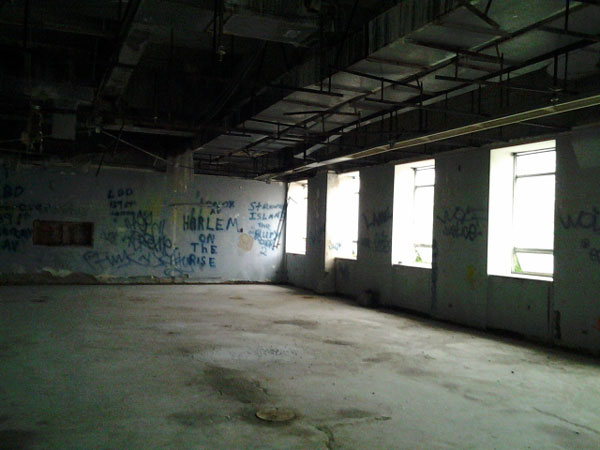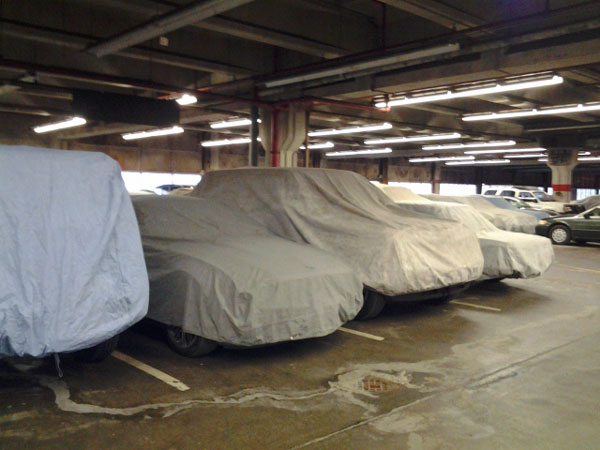
BY KAITLYN MEADE | Despite widespread alarm when the Consolidated Edison Company of New York shut off power to protect Lower Manhattan from Hurricane Sandy, the Hudson River Park Trust could only breathe a sigh of relief. Pier 40, the deteriorating pier near Houston St., narrowly avoided catastrophe during the storm.
Madelyn Wils, president of the Hudson River Park Trust (H.R.P.T.), said that while power could be shut off in most of Hudson River Park’s buildings, they were unable to do so at Pier 40 because the substation was very old.
“We’re very lucky that Con Edison turned off power for the whole area,” Wils said Thursday in a phone interview. “If they hadn’t turned it off, the transformer would have exploded and that would have started a fire. It could have been a disaster.”
The storm did extensive damage to the ball fields although the turf was already nearing its end.
This is only one of many problems plaguing the structure of the pier, which turned 50 years old on Oct. 24. Long before Hurricane Sandy, the pier was in dire need of repair.

At a recent tour of Pier 40 with Community Board 1, Madelyn Wils and Mark Conti, project manager of construction and design for the LiRo Group, a consultant for Pier 40, discussed the myriad problems facing the pier and the necessary measures to bring the building back into working order.
When the H.R.P.T. inherited the building from the Department of Buildings and the Port Authority of New York and New Jersey in 2003, the roof was caving in and extensive water damage had occurred from rainwater pouring through the leaks.
“Instead of fixing the ceilings, they actually built giant bathtubs for the rainwater,” said Conti. But even these contained asbestos in the lining that had to be removed.
Meanwhile, the concrete ceiling panels have corroded. In fact, in certain parking sections, every car is given a plastic covering as protection from falling concrete. Sometimes this is not enough and the vehicles incur cracked windshields from loose pieces of the garage’s ceiling.
The sanitation system collapsed about a month ago. Inclement weather caused the river to snap the pipe that runs beneath the pier, adding a whole new set of worries to the already cash-strapped reconstruction project. A pump has been set up, but it is one of a long line of temporary fixes that must be implemented to keep the pier running in the short term. Another temporary solution is the external emergency stairway placed on the outside corner of the building in lieu of the internal staircases, all six of which are condemned.
According to Wils, it is the basic structure that is in most need of immediate attention. “What we’re seeing is the deterioration of structures that are vital to the life and safety of the building,” she said regarding the 3,600 steel piles that make up the pier’s skeleton. “Steel is good if you take care of [the piles], but they didn’t.”
Nearly a fifth of the roof has been repaired at a cost of $6.2 million, but the H.R.P.T. lacks the funds to finish the job.
With a footprint of 15 acres, Pier 40 is the largest of the Hudson River Park’s piers by five to six times. and is the only large, commercial pier in the lower section of Hudson River Park. Historically, it supplied about 40 percent of the park’s revenue at about $7.5 million. But that amount dwindled to $5 million in the past year.
“Pier 40 was supposed to support Hudson River Park, but now, the park is supporting Pier 40,” Wils told C.B. 1 members during the tour.
At an Oct. 15 meeting of C.B.1’s Waterfront and Tribeca Committees, H.R.P.T.’s monetary tribulations were discussed along with tentative plans to partially close the pier in sections.
The meeting opened with committee chair Bob Townley discussing crime prevention on the waterfront — prompted by the recent assault of a young woman in early October. He noted an increase in crime on the waterfront, especially petty larceny but also in “serious crime.” He advocated for a community dialogue on how to make the waterfront safer and expressed his desire to engage with residents about their experiences late at night on the waterfront.
The next order of business was a presentation by Wils to the board on the financing woes and options currently facing Pier 40. One year ago, Wils worked with a task force consisting of members from Community Boards 1, 2 and 4, which Hudson River Park traverses, along with local groups to determine the pier’s needs. The good news: Hudson River Park draws a lot of people, second only to Central Park in Manhattan. Approximately 400,000 people play sports in the park yearly, while 6,000 children use its educational programs and 3,300 people are employed within its boundaries.
The bad news is that Pier 40 is an unsustainable part of the park. In fiscal year 2013, the pier ended with a $7 million deficit. Furthermore, the roof repairs alone will cost $24 million in addition to the approximately $6 million already spent. The steel piles need to be encapsulated in fiberglass or plastic. The fixes to the steel piles would amount to $90 million if they were all to be done within a year, but that estimate will rise if they are stretched over a decade.
“We need $250 million to finish the public portions of the pier,” Wils reported. “If we continue at this rate, there will be an $82 million deficit in ten years.”
The option that Wils laid before the board was a managed shutdown of the pier, which would entail closing one section at a time for repairs and moving parking to areas that are not under construction and keeping the ball fields open. The pier currently has the capacity for 2,600 parking spaces, but usually only 1,700 of them are used. Such a shutdown could save the H.R.P.T. up to $5 million per year, allowing it to keep the pier open for another five-to-six years as it figures out how to pay for repairs and raise revenue to support the park.
Wils said the Trust was “agnostic” when it came to forms of development and other uses of the pier that could raise revenue, but she warned that too much retail would cause traffic problems that the pier could not support. Revenue potentials include increased commercial use, residential development and head fees on commercial ships that dock at the pier and use its facilities. She also cited three different parking studies that determined that parking alone could not save the pier. “There’s not one answer — but we need all the answers to make Pier 40 work,” she said. “We need to have many different sources.”
The community, however, is skeptical of the impact of commercial and residential development, as shown by two failed Requests for Proposals issued by the Trust.
New York State Assembly Member Deborah Glick responded by asking the H.R.P.T. to present a “holistic vision of the entire park before we try to plug the gap with an ‘anything goes’ philosophy at Pier 40.” She suggested looking at the Hudson River Park Act to see what revenue streams are already feasible, to assess an “adaptive reuse” of the existing building and to solicit public funds for repairs.
“The notion that the collective will of the entire West Side is incapable of getting some of the deferred maintenance covered is actually wrong,” Glick said.
The assembly member agreed that retail would not be a good option — besides overcrowding the pier, it would struggle between November and February with the cold wind rising from the river. Yet the idea of a high-tech campus or gallery space with consolidated parking, she said, were both options that should be investigated before residential development.
“We don’t have open space. We can’t make more open space. We can only prevent the loss of more open space,” said Glick.
The Pier 40 Champions, a new coalition of sports leagues that includes the Downtown United Soccer Club, the Gotham Girls Football Club, the Greenwich Village Little League and the Pier Park and Playground Association, believe that residential development at the pier might be the best way to salvage their playing fields. These leagues funded a study last April, which concluded that limited residential development would have the lowest impact for the highest revenue compared to other options. With this in mind, Pier 40 Champions has hired WXY Architecture & Urban Design to plan a narrow, 15-story tower situated between the pier and the Hudson River bike path that would be comprised of residential and possibly commercial units. This would require rezoning and a change to the Hudson River Park Act, since both prohibit residential use.
Friends of Hudson River Park, which is less concerned with the use of the pier itself, has presented its own idea for supplying funds for the park. The group has proposed a waterfront Neighborhood Improvement District stretching from 59th Street all the way to about Chambers Street and extending two to four blocks away from Hudson River Park. The N.I.D. would set up an annual property owners assessment fee of 7.5 cents per square foot for residential property (excluding public housing) and 15 cents per square foot for commercial lots.
The assessment would generate a projected $10 million annually, with 40 percent going toward community needs and 60 percent going to the park.
“The feedback has been mostly positive,” said Matthew Washington, a member of the Friends’ N.I.D. committee. However, the Friends can’t submit the proposal to the city Department of Small Business Services until it can prove in ballot form that the majority of neighborhood property owners are in favor of it. The group will be distributing and collecting the ballots between November and next February.
Some committee members questioned whether such a broad range of neighborhoods would share enough of a common interest to agree on the proposal. “How are you separating the neighborhoods? How would you know if one neighborhood didn’t agree?” asked C.B.1 Waterfront Committee member Marc Ameruso.
Michael Levine, C.B. 1’s director of land use and planning, maintained that all three community boards are behind the plan. “The issue is going to be the property owners,” he said.
The F.H.R.P. hopes to have the N.I.D. up and running by fiscal year 2014. In the meantime, the staff of the Trust is in the process of assessing Pier 40’s condition after hurricane Sandy.
However, Wils noted that the newer piers and bulkheads fared “remarkably well,” and that the staff is thankful that what damage they have so far encountered can be repaired. “We had a very close call here,” she said.

















